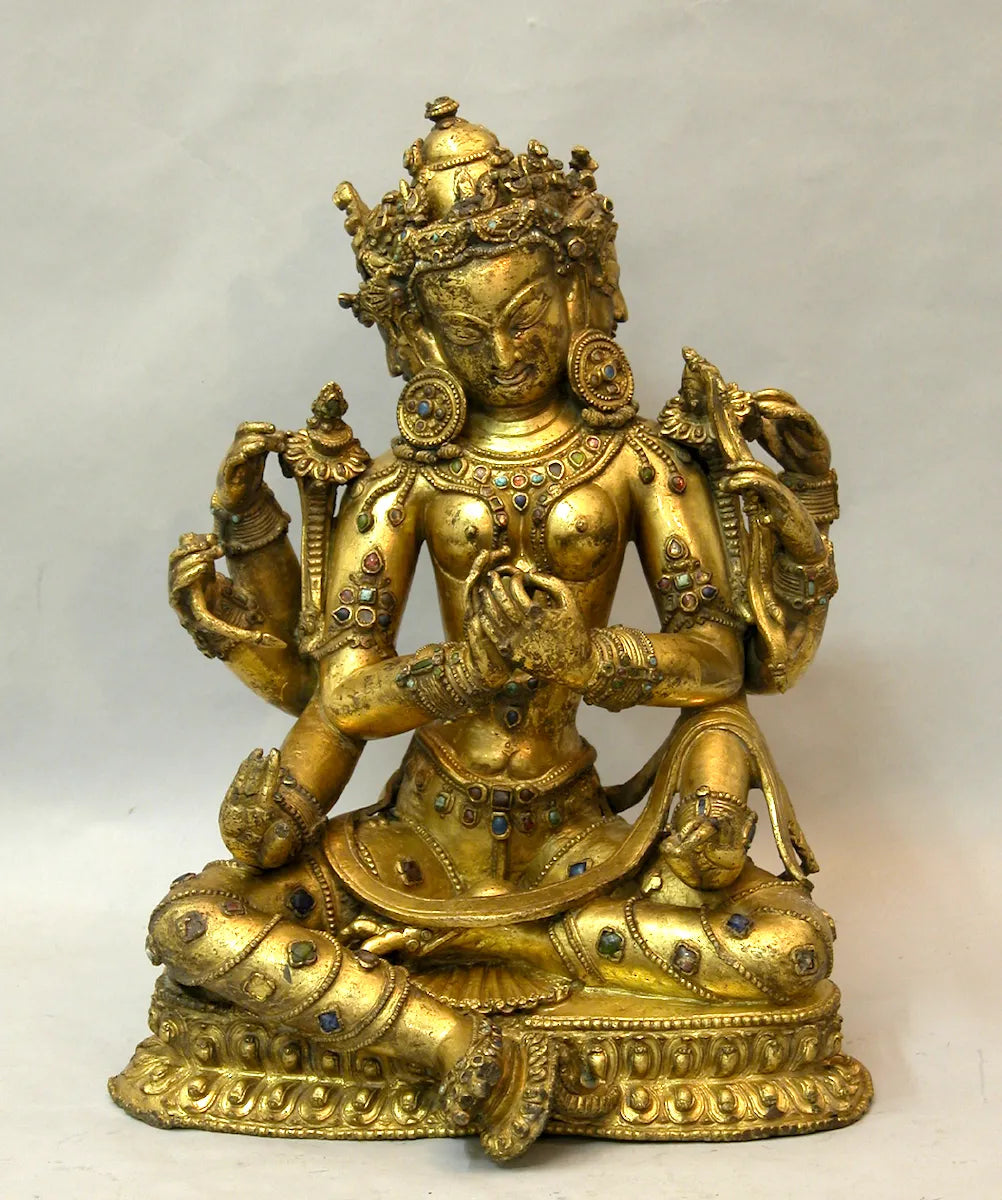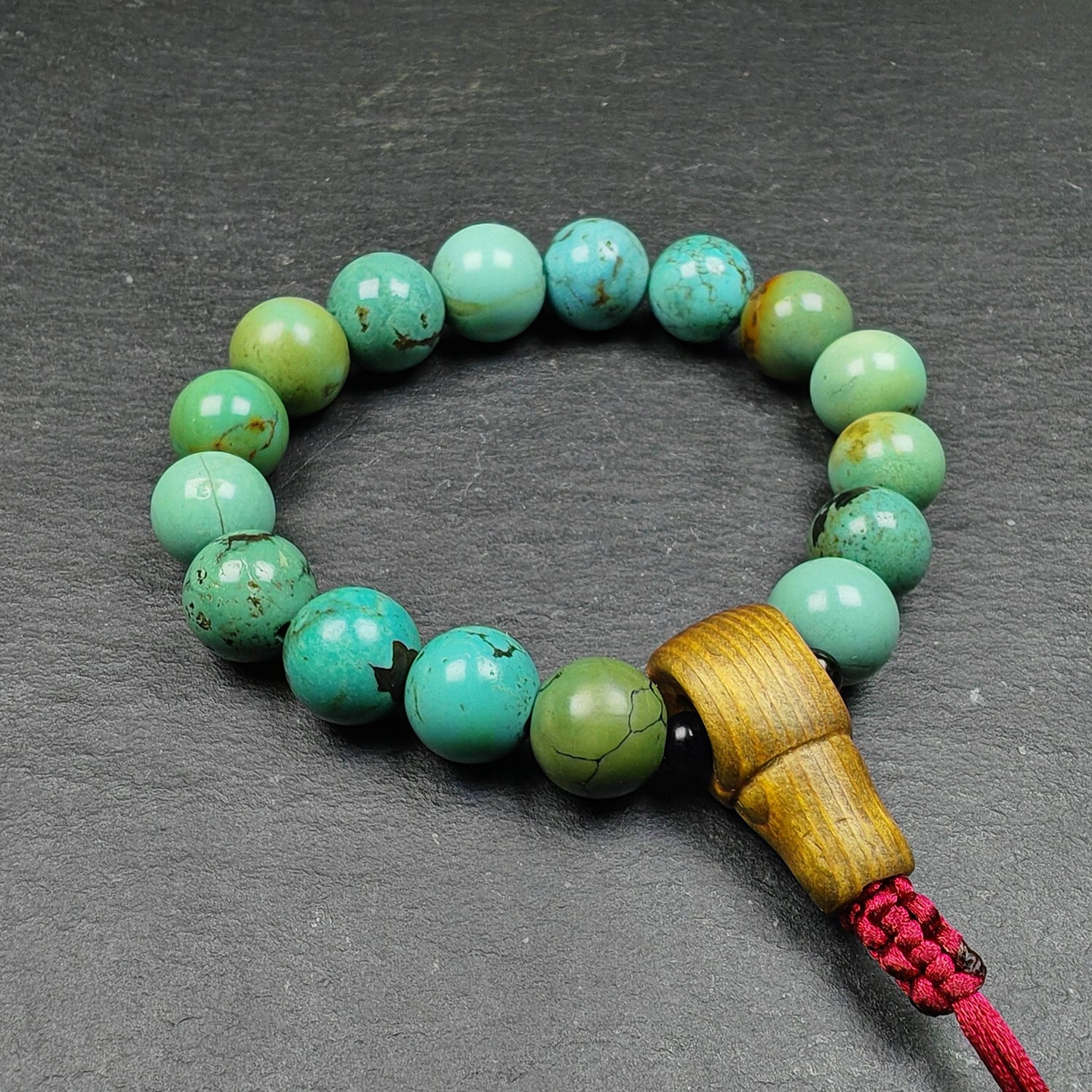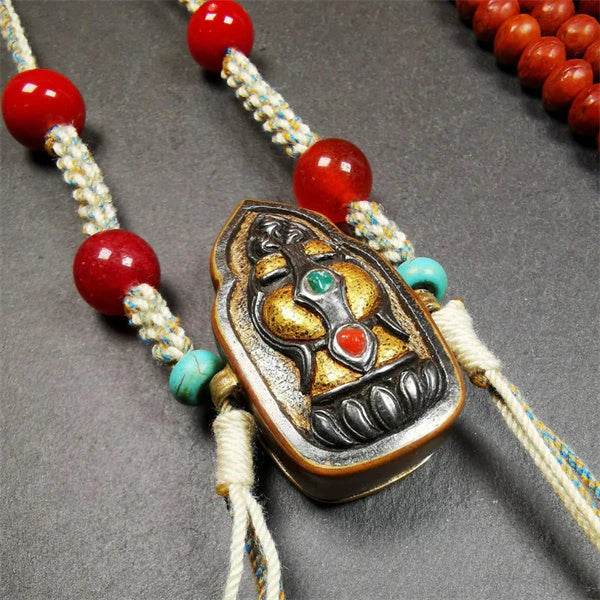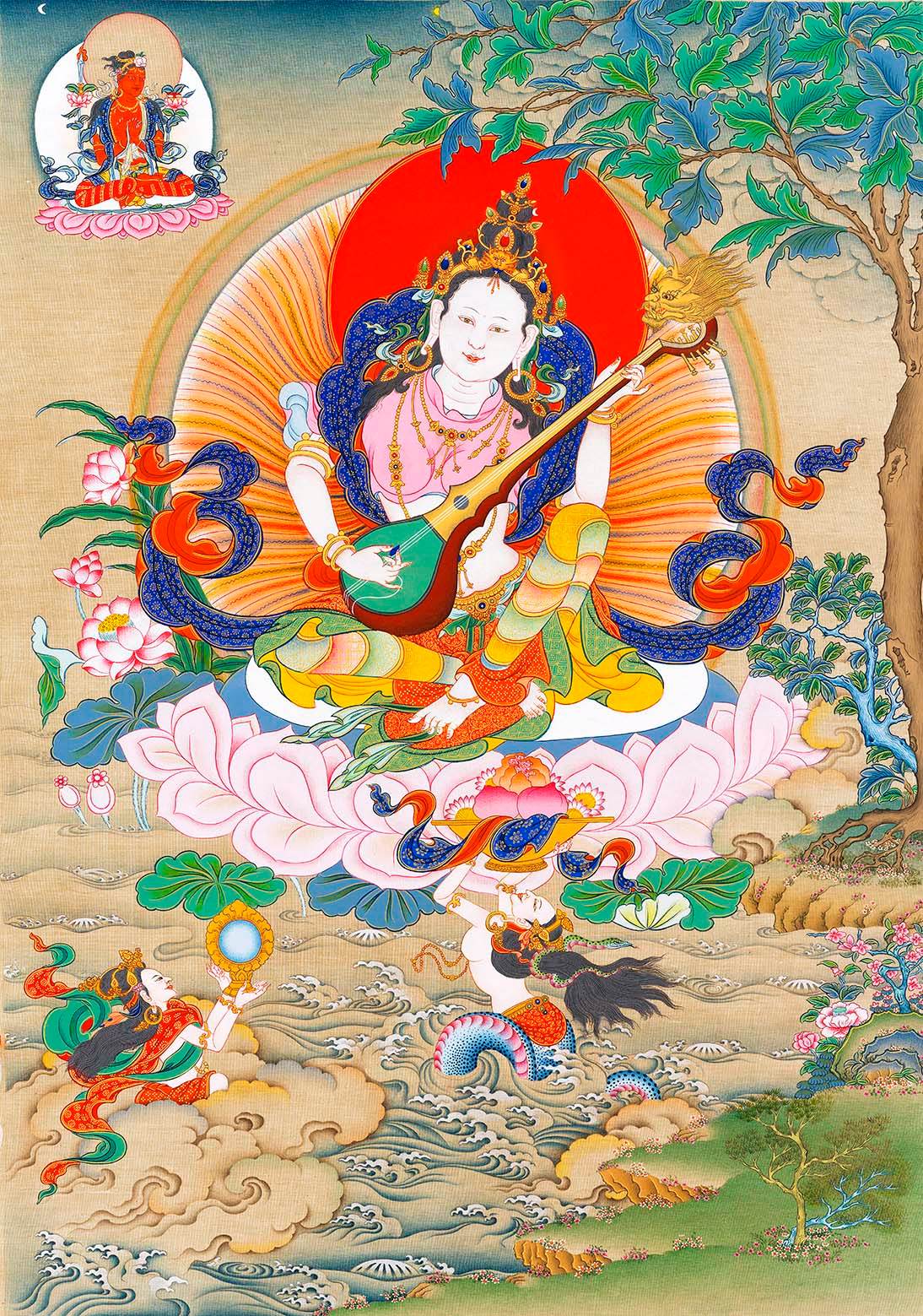
Copper and Iron Are Also Treasures ▎Tibetan Treasures Series

*Eight-Armed Tara Gilded Bronze Statue Adorned with Jewels*
Densa Thil Style Statue
Late 14th Century, Collection of the Capital Museum

*Supreme Standing Brass Statue in the Deer Park Style*
Kashmiri Style
Late 11th Century, Collection of the Tibet Museum

*Vajrasattva and Consort Brass Statue*
Kashmiri Style
11th Century, Collection of the Potala Palace, Lhasa

*Gilded Iron Celestial Scepter with Silver Inlay*
Yongle Period, Ming Dynasty (First Half of 15th Century)
Partial View, Height 77.3cm, Collection of the Potala Palace, Lhasa
ཨོ་ཌི་བི་ཤ་ལས་བྱུང་ལྕགས་ནག་ནི།
ཤ་རུས་མ་ལུས་ཤིང་བཞིན་གཅོད་པར་བྱེད།
ལན་གཅིག་བསྣུན་པས་གླང་ཆེན་ཕྱེད་ཚལ་བཅད།
རིན་པོ་ཆེ་ཡིན་གསེར་དང་རིན་ཐང་མཚུངས།
རྒྱ་ནག་ལྕགས་བཟང་རྣོ་ཞིང་གྱོང་མཉེན་འཛོམ།
ལྕགས་ངན་ངར་མེད་བཟོ་རིགས་སྣ་ཚོགས་གྲུབ།
བོད་ལྕགས་དཀར་མཉེན་ལྷུང་བཟེད་རྒྱུ་ལ་བཟང།
ཁམས་ཀོང་ལྕགས་ངར་སོ་ནམ་ལག་ཆ་ཡིན།
The Fine Iron from Odvisha
Can split flesh and bone like felling a tree,
With one stroke can sever an elephant's body,
All say this treasure rivals gold in worth.
Han iron, sharp yet both hard and supple,
Inferior iron, blunt but fit for crafting tools,
Tibetan iron, white and soft, ideal for bowls,
Kham and Kongpo iron, sharp, best for farming tools.
— From *A Concise Guide to Analyzing Precious Substances* (རིན་པོ་ཆེ་བརྟག་ཐབས་མདོར་བསྡུས་གསལ་བ་)
By Longdol Lama Ngawang Lozang (ཀློང་རྡོལ་བླ་མ་; 1719-1794)
Note: "Odvisha" refers to present-day Odisha in South Asia, known in ancient Buddhist texts as Kalinga (ཀ་ལིང་ཀ་). This region had significant metal trade with Tibet. "Kham and Kongpo" denote the Kham and Kongpo regions.

**Blue Beryl Medical Thangka: Properties and Potency of Medicinal Substances**
Early 20th Century, Lhasa Men-Tsee-Khang Collection
Detail: Natural Copper — Iron-Bearing Copper — Gold-Bearing Copper — Various Iron Ores
Iron-bearing copper produces a harsh sound when struck, called "male copper."
Gold-bearing copper produces a clear, resonant sound when struck, called "female copper."

Blue Beryl Medical Thangka: Properties and Potency of Medicinal Substances
Early 20th Century, Lhasa Men-Tsee-Khang Collection
Detail: Superior/Inferior Chalcanthite — Cassiterite — Tin
(Some texts also refer to "tin" as "white iron")
ལི་དཀར་ལི་སེར་ལི་དམར་དང།
ལི་ཁྲ་ལི་སྨུག་རོལ་མོ་བཅོས།
སྐད་སྙན་བྱུང་ན་བཟང་བ་ཡིན།
སྐད་མེད་མདོག་ནག་བལ་པོ་དང།
ཁམས་བོད་ལི་བརྫུས་སྣ་ཚོགས་འབྱུང།
(…..)
མོ་རག་རྡོ་རག་སེར་ཞིང་གྱོང་མཉེན་ལེགས།
ཕོ་རག་རག་སྐྱ་བཅོས་པའི་རག་ཡིན་ངན།
པད་སྡོང་དངུལ་འདྲ་ངན་པ་འཁར་བ་འདྲ།
ལྗོན་དམར་ཟངས་འདྲ་སྡོང་དཀར་ལྕགས་དཀར་འདྲ།
**Three Types of Bell-Metal: White, Yellow, and Red**
Variegated and purple bell-metal make fine instruments—
Those with clear, pleasant tones are superior,
While dull, dark-toned ones are inferior.
Fakes abound in Nepal, Tibet, and Kham.
(...)
**Female brass-ore**—yellow, both hard and soft;
**Male brass**—pale, yields inferior crafts.
Like silver lotus stems, next best to bell-metal,
Like copper-red trees, whitish as tin.
— From *A Concise Guide to Analyzing Precious Substances*(རིན་པོ་ཆེ་བརྟག་ཐབས་མདོར་བསྡུས་གསལ་བ་)
By Longdol Lama Ngawang Lozang (ཀློང་རྡོལ་བླ་མ་; 1719-1794)
*Note: "Nepal, Tibet, and Kham" refer to Nepalese regions, Central Tibet, and the eastern Kham area.
"Stems and sacred trees" are classical metaphors—here "stem" denotes white lotus stalks.*

**Bell-Metal Stupa Adorned with Jewels in Lotus Cluster Design**
Western Tibetan Style
Mid-15th Century, Excavated from Meditation Caves near Hemis Monastery
Photo courtesy of the Asian Art Museum
A Bronze Casket and Iron Nails: The Sovereign's Remains Cast into the River
Encased in a copper coffin, fastened with iron nails, the remains of the king-father were cast into the river. The traitorous minister seized the throne, the prince fled into exile, and thus began a thirteen-year saga of vengeance. In the end, with the aid of a loyal advisor, the prince reclaimed his rightful place, and the people wielded copper and iron to punish the conspirators.
In this tale, passed down since the Tibetan imperial era, "copper and iron" carry profound symbolism—metals that bore witness to the dynasty's darkest hour. The prince who reclaimed the throne was none other than Pude Gungyal (སྤུ་དེ་གུང་རྒྱལ་ / པུ་དེ་གུང་རྒྱལ་), the ninth emperor of Tibet, and his cunning advisor was Rulakye (རུ་ལས་སྐྱེས་). According to historical Tibetan records, Rulakye and his son Lhabu Gokar (ལྷ་བུ་མགོ་དཀར་) were exemplary ministers of the empire. Under their stewardship, Tibet's agriculture and metallurgy flourished.
Gold, silver, copper, iron, and tin (some texts list gold, silver, iron, red copper, and bronze) were metals shared by rulers, ministers, and commoners alike. Gold, silver, red copper, tin, iron, brass, bronze, and lead—these were the eight essential metals born from the earth.
We cannot claim this period as the dawn of metallurgy in Tibet. Archaeological findings from recent decades reveal that Tibetan civilization had already entered the Bronze Age by at least 4,000 years ago. Evidence suggests extensive exchanges in metallurgy—particularly in copper and iron—between Tibet and East, South, and North Asia. The era of Pude Gungyal likely marked the twilight of the Iron Age.
Hardened iron was the material of weapons (མཚོན་ཆ་བྱེད་པ་), while red copper, dark as a "barbarian's face" (ཀླ་ཀློ་ཁ་), was the earliest form of copper used. Legends from South Asia, claiming copper originated from a "red tree" (ལྗོན་དམར་), long persisted in Tibet. Brass and bronze, as copper alloys, were subjects of great scholarly discourse in classical times.
Brass (ར་གན་ / རག་), golden in hue, was the standard material for crafting sacred images, while bronze, noble as a lotus, was honored as the "stainless material" (དྲི་མེད་རྫས་). Notably (though debated), Tibetan tradition classified bronze into two types: high-tin bronze (ལི་, or "bell-metal"), considered superior, and ordinary bronze (འཁར་བ་), which also held its own distinction.

**Miniature Yak-Form Copper Alloy Statuette Defined as "Thokcha"**
Left: Pre-Buddhist Period ─ Right: Imperial Period
Photographed by archaeologist John Vincent Bellezza
On the Composition and Usage Paradigms of "Thokcha" (གནམ་ལྕགས་)
Several complementary theories exist in contemporary academia.

Copper Alloy Spouted Jar with Handle in Avian Form
Proto-Historic Period (ca. 1st–6th century CE)
Private Collection, Photographed by Mark French

Samye Monastery Bronze Bell
Cast in 797 CE (During the Reign of Tibetan Emperor Trisong Detsen)
Commissioned by Queen Jamo Tsen (རྒྱལ་མོ་བཙན་)
Photo by Michael Henss

Smelting Bellows Pipe Excavated from Gachong Village Site, Lhasa
The site dates back approximately 3,000 years, with artifacts resembling South Asian counterparts
Image from Discovery and Preliminary Study of Smelting Relics at Gachong Village Site, Duilongdeqing County, Tibet

**Tibetan Bronze Mirror with Handle**
Iron Age, Total Length 28cm
Private Collection, Photo by Mark French
(The origin of Tibetan bronze mirrors remains widely debated)
From the perspective of existing literature, the excavation history of Tibetan copper/iron ores, the evolution of copper/iron craftsmanship, and related mineralogical studies still require extensive summarization and supplementation. Undoubtedly, modern archaeology and ore research have provided numerous fresh perspectives. Western Tibet's pivotal role in proto-historical metallurgy, the relationship between copper/iron technologies and early sociopolitical power structures, and contemporary reinterpretations of traditional terminology—all these subjects continue to expand our understanding of Tibet's metallurgical systems (particularly regarding gold, silver, copper, and iron). While copper/alloy-cast ritual objects and iron-forged weapons receive distinct emphasis in Tibetan descriptions (though not absolutely), some craft treatises metaphorically assign yin attributes to copper and yang to iron (excluding gold), carrying implicit social symbolism.
In indigenous beliefs, metal artifacts were thought to possess unique vitality, serving as ritual mediators. During the imperial era, escalating military demands and later Buddhist iconographic stylization elevated artisans' status (historical records even identify the clan of minister Gar Tongtsen as blacksmiths). Traditionally, central Tibet classified gold/silver/copper smiths as "white artisans" (དཀར་བཟོ་) while ironworkers were deemed "black artisans" (ནག་བཟོ་)—a stigmatized identity later associated with "ritual impurity" due to weapons-related bloodshed. Yet, the Ganden Phodrang period established formal guilds with codified regulations for metalworkers. Despite enduring social marginalization (especially for blacksmiths), these craftsmen remained indispensable creators of both sacred implements and utilitarian objects.

**Great Terton Pema Lingpa**
19th Century, Private Collection
Pema Lingpa (པདྨ་གླིང་པ་; 1450-1521)
Trained as a blacksmith from childhood and crafted sacred copper/iron objects
**The sage Thangtong Gyalpo (ཐང་སྟོང་རྒྱལ་པོ་; 1385-1509)** depicted at lower right
Supervised the construction of numerous iron bridges across the Himalayan region

**Detail Photo of Iron Bridge Built by Thangtong Gyalpo**
Photographed by architect Manfred Gerner
Original caption: Remains uncorroded after 555 years

**The Eighty-Four Mahasiddhas Thangka**
Detail: Mahasiddha Kambaripa (ཀམ་པ་རི་པ་)
Mid-to-late 18th century, Rubin Museum Collection
**This mahasiddha was originally a blacksmith**
Buddhist systems and South Asian societies rarely exhibited such discrimination
Tibet's "blacksmith stigma" constitutes a localized normative system

A Group of Blacksmiths Working in Lhasa's Armory
Photographed between 1920-1921
Presumably taken by Mr. Rabden Lepcha
Original plate housed at St Antony's College, Oxford University

**Tibetan Dagger with Silver-Inlaid Treasure-Decorated Scabbard**
18th-19th Century, The Metropolitan Museum of Art Collection

**Vairocana Bronze Statue in Royal Attire Style**
Mid-11th Century, Pritzker Private Collection






